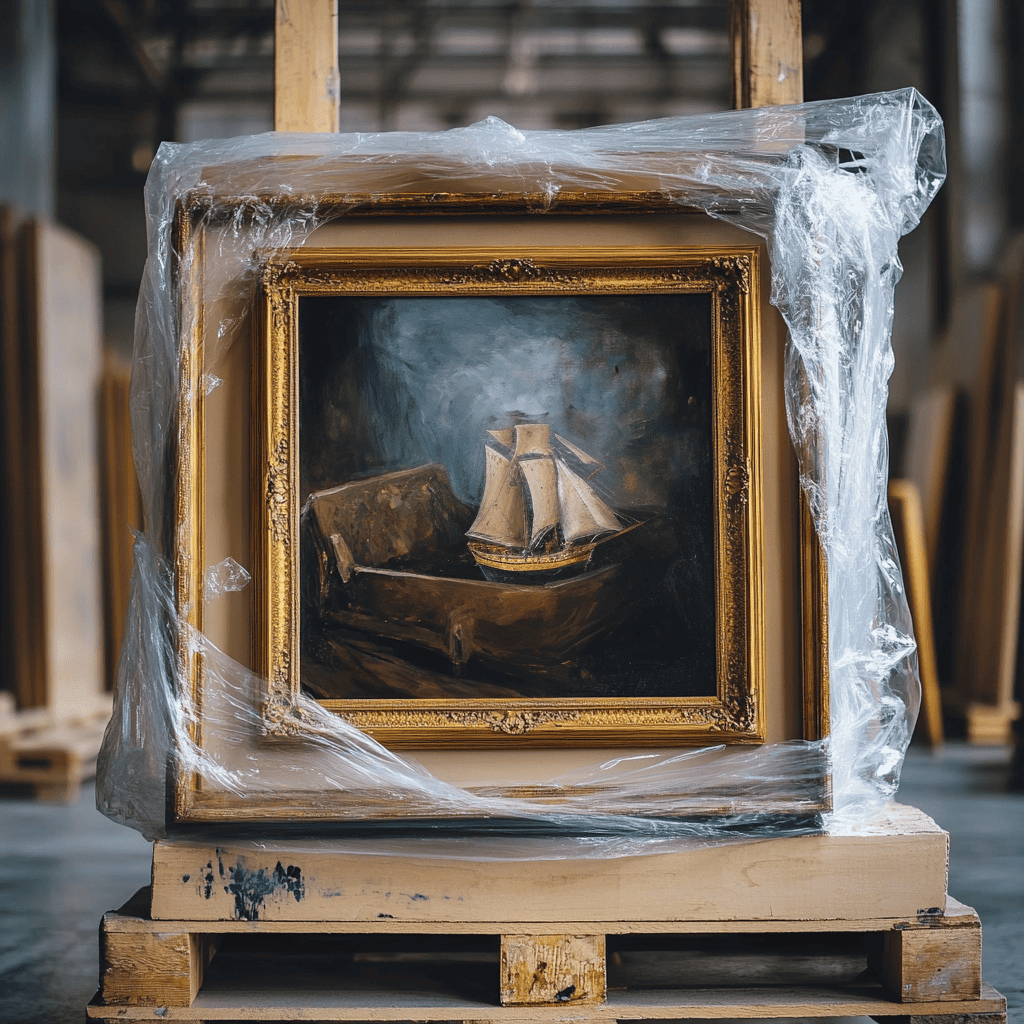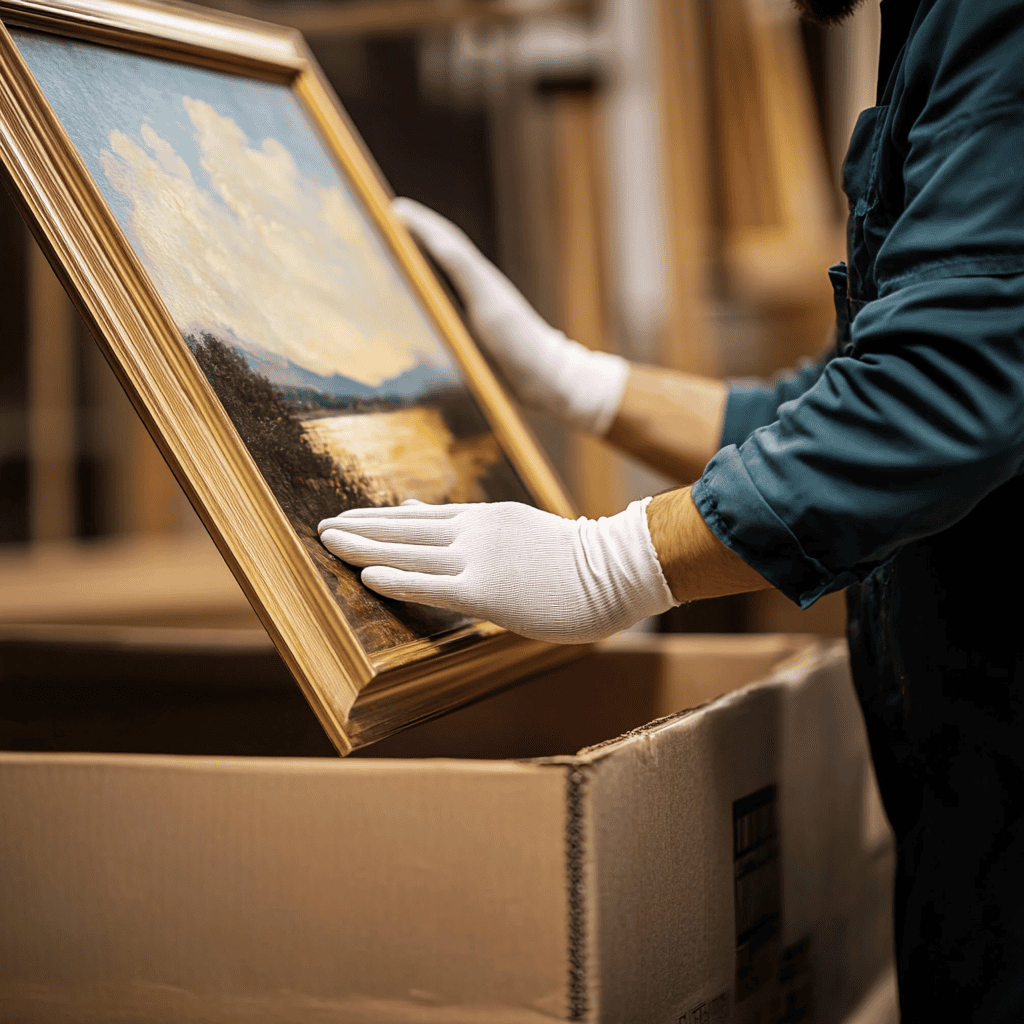So, you want to ship a painting, but you’re worried it might get damaged in transit.
That’s understandable.
Maybe you’ve also heard some alarming stories about art shipping mishaps:
A faulty sprinkler almost soaked the Mona Lisa in 1963.
A 360-year-old Rembrandt was destroyed in transport in 2001.
The good news?
With proper packaging and shipping, you can significantly reduce the transport risk.
But “proper” goes beyond packing tape and cling film.
Ready to learn how to ship a painting safely?
Whether you’re sending a large painting or a small piece of artwork, the comprehensive guide below will help you get it to its destination in tip-top shape. (And with more than 10 years of experience shipping large, fragile packages, you can listen to our advice.)

PRO TIP: If you sell paintings, frames, or other large products online, Red Stag Fulfillment can handle your fulfillment operation. We specialize in big, fragile, and valuable items, offering expert packaging, reduced shipping costs, and a zero shrinkage guarantee.
To learn more about how we can handle the heavy lifting of your art fulfillment, reach out today.
How to ship a painting of any size in 15 easy steps
Ready to become a painting shipping pro?
Follow these steps to ensure your masterpiece arrives safe and sound at its destination.

Understand the challenges of shipping artwork
01
If you’re a painter or work in the art business, it’s probably OK to skip this step because you understand how fragile artwork is.
For most people, learning about specific risks is crucial because it allows you to consider possible scenarios and the potential implications for shipping costs.
Below is a table of potential damages and how they usually happen.
| Painting damage in transit | Why/how it happens |
|---|---|
| Cuts | Knock, drop, or pressure of other packages |
| Dents/bends | Similar scenarios to cuts, only less harsh |
| Abrasions (canvas or frame) | Inadequate wrapping, padding, or securing |
| Smudges | Similar scenarios to abrasions |
| Water damage | Warehouse or truck leaks—either from rain or other packages |
| Chemical damage | Non-neutral first layer of packaging (usually acidic) reacts with the paint |
| Rodent damage | Rarely happens, but it’s possible when shipping a painting internationally |

PRO TIP: Consider leaving the packing to the professionals. UPS and FedEx both offer pack-and-ship options.
Consider the specifics of your painting
02
The best way to ship paintings is by tailoring your packaging materials and shipping techniques to your specific artwork.
- Pastel paintings are especially sensitive to damage.
Consider shipping them double-boxed to reduce the risks. - Charcoal art does not respond well to movement because it smudges easily.
Ship it compressed and secured in a foam core. - Oil or acrylic impasto paintings are delicate.
Thick impasto paint calls for extra protection.
Secure plywood or plexiglass board a few inches above the canvas to protect the painting.

NOTE: Understanding your painting’s specific shipping risks—and packaging it accordingly—will drastically reduce its risk of damage during transit.
Decide between shipping framed and unframed
03
To frame or not to frame? That is the question.
Frames are sturdy, provide extra protection, and make packaging easier.
But a glass front is risky.
If the glass breaks or chips, the damage to the painting can be catastrophic.
Shipping a framed painting
You have three main options for shipping a framed painting:
01
Frame the painting with no additional protection (common for oil on canvas).
02
Frame the painting behind glass (usually watercolor, pastel, or pencil art).
03
Frame the painting with non-glass protection, like an acrylic board (OK to ship as is).
The second scenario is the most problematic.
If that’s your situation, ship the painting and the glass separately. This lowers the risk but adds steps to the process.
Shipping an unframed painting
Shipping unframed is practical for (some) unmounted canvases.
For most unframed paintings, these are your options:
01
Ship it rolled and packed in a tube.
02
Ship it flat within layers of protection.
In most cases, the latter is much safer.
Rolling a painting might be acceptable for prints, thin acrylics, and some oils.
For others, it introduces the risk of cracking.
It’s different from rolling for storage because shipping might mean temperature/humidity changes, bumps, and shifting.
Never roll the following paintings:
- Aged oil or acrylic painting.
The film on these is no longer flexible. - Fresh oil paintings that haven’t fully cured.
These might crack and even partially peel. On average, an oil painting takes six to 12 months to dry. - Large paintings.
There’s no fast rule here, but any piece over 5 feet (on any side) is probably too big to roll.
How to ship paintings rolled—steps and best practices
Shipping a painting flat is the conservative (read—safer) way to do it.
If you still decide to roll and ship, keep these tips in mind:
01
Place two to four sheets of glassine paper on a table and lay the painting face down. The sheets should be about 2 inches bigger than the canvas.
02
Always roll outwards—paint is more flexible when curving out than onto itself. In other words, it’s more resistant to stretching than squishing.
03
Always roll along the short side (bottom to top)—a shorter roll will be more rigid.
04
Stabilize it—you’ll want to roll the canvas onto something (like a cardboard roll).
05
Roll slowly and loosely to lower the risk of cracking.
06
Smooth out any creases on the canvas side, as it can scrape the paint.
07
Rolling larger paintings is a two-person job—have someone hold the opposing edges. It makes every step above easier.
08
Think about the unrolling—use distinctive tape that won’t blend with the paper, fashion the ends into tabs, and distribute them evenly. This will make unpacking easier when the art arrives.
09
Use a heavy-duty mailing tube about 5 inches longer than the rolled art.
10
Roll layers of bubble wrap until the package fits into the tube with minimal movement but no warping, with the bubbles facing outwards.
11
Consider shipping the tube in a larger box for added protection.
12
Lid up and tape the tube for extra security. Shipping rolled art without tight end caps isn’t an option.
13
Label “FRAGILE” and add unpacking instructions if needed.

PRO TIP: Aim for a “zero-gravity” effect inside the tube. Use foam end caps and strategically placed bubble wrap to suspend the rolled artwork, preventing it from shifting or touching the tube’s sides during transit. This reduces the risk of damage from vibrations or impacts.
Measure the painting
04

The exact measurement and weight of your painting will help you:

Choose a carrier.

Choose the box and packing materials.

Keep size limits in mind.

Decide between a box and a crate.
How to ship a large painting
If any one side of your art (frame included) is over 4 feet, you’ll want to ship it in a wooden crate for a few reasons:

A large box is more likely to collapse under other packages.

A wooden crate can be customized to the exact size of your art.

Large artwork is typically more expensive—the value might exceed the insurable amount.
The main downside is that shipping a large crate will cost more.
Choose a carrier (shipping company)
05
You have three options when it comes to choosing a carrier:

USPS is cheaper on shorter routes but less flexible (especially in terms of package size).

Specialized art-shipping companies are expensive and typically worth it for high-value pieces.
Shipping costs compared
The table and graph below compare the shipping costs for a medium-sized painting (calculated at base daily rates by shipping zones).
The assumed specs:

A 2-inch thick framed canvas, measuring 16 inches by 20 inches and weighing 5 pounds.

The outer box size is 5 inches bigger than the painting (on all sides).

The total weight is 7 pounds.
| Carrier | Zone two | Zone three | Zone four | Zone five | Zone six | Zone seven | Zone eight |
|---|---|---|---|---|---|---|---|
| UPS | $19.88 | $22.82 | $24.46 | $29.15 | $36.52 | $43.31 | $49.34 |
| FedEx | $20.00 | $22.96 | $24.61 | $29.35 | $36.52 | $43.31 | $49.34 |
| USPS | $12.05 | $12.85 | $14.30 | $44.65 | $54.00 | $64.05 | $75.20 |
Disclaimer: These calculations and graphs are approximations for reference purposes only.
UPS and FedEx charge similar prices for bigger paintings.
There are three key takeaways here:
- Consider USPS for closer ZIP codes (up to Zone four).
Starting with Zone five, it will cost about 50% more. - UPS and FedEx charge similar base rates.
The differences are minor, and the two appear as one line on the graph. - USPS has rigid maximum size rules.
It starts with 108 inches (girth and length combined), and they’ll add a surcharge for oversized items (see all their size limits here).

PRO TIP: When shipping a painting, many carriers will calculate your cost using dimensional weight instead of physical weight. This means the dimensions of the package will determine the shipping cost, not the physical weight. You can calculate the cost of shipping using our dimensional weight shipping calculator.
Add-on services and special handling for shipping artwork
Some people may be OK with shipping art via standard shipping.
This is especially true if they’re buying art prints from an online shop.
But add-on services like guarantees and special handling can give shippers—and buyers—more peace of mind for higher-value or more delicate artwork.
| USPS | FedEx | UPS | |
|---|---|---|---|
| Add-on services | Ground advantage retail—if you don’t want your painting on a plane | Overnight options—first, priority, and standard 2 Day | Next Day and 2nd Day Air 3 Day Select UPS Ground |
| Special handling options and limits | Maximum weight is 70 pounds, maximum combined length and girth is 130 inches. | Add-on cost for fragile packing (adds $100-150 to the base fee) | Pack and ship guarantee |
| Carrier shipping calculators | USPS calculator | FedEx Calculator | UPS calculator |
Sort out the shipping insurance and declared value
06
Shipping insurance for art is a complex topic that probably deserves its own guide.
Below is the gist of it.
Pay special attention to the following:

Declared-value limits

Liabilities not covered (specific to art)

Proving the insured value

Return labels expiry
Declared value of a painting
With FedEx, the maximum declared value is $1,000 (declared value details here).
With UPS, the max declared value can vary.
It depends on where you ship from and who creates the labels.
Two bonus tips:
- Declared value is not the same as insurance.
It’s the carrier’s maximum liability and is subject to limitations. - FedEx and UPS return shipping labels last 30 and 90 days, respectively.
Bear this in mind if shipping artwork for an exhibition.

PRO TIP: Purchasing insurance from an agent/broker is a smart move if you’re shipping a particularly valuable piece.
Purchase shipping supplies—tools and packing materials
07
Time to gear up.
Here’s what you’ll need to pack and ship artwork:
Tools:

Scissors

Measuring tape and ruler

Craft knife/box cutter

Gun tacker
Supplies:

Acid-free glassine paper

Bubble wrap

Foam board

Cardboard corner protectors

Tape—packing, adhesive, and painters

Cling film

Craft knife/box cutter

Kraft paper

Air-plus fillers

Tissue paper

Marker pen

Sharpie

Blank and special labels (Fragile, This Side Up)

Cardboard box (suggested sources—Boxes4U, UPS, FedEx)

Plywood or acrylic board (cut to size).

Plastic bag for waterproofing.

Cotton gloves.

NOTE: Tailor your supplies to your painting and packing method. This list is comprehensive—you likely won’t need every item for a single shipment.
Slip on a pair of cotton gloves
08
Cotton is gentler to the canvas than your skin, especially if you tend to sweat.

Cotton gloves are cheap, neutral, and thin enough not to get in the way.
As an alternative, use glassine paper when touching the canvas.
Gently protect the canvas with acid-free glassine paper
09
Only archival-quality paper should come in contact with the paint.
The most widely available is glassine paper.
Here’s the process of creating that first packing layer:
01
Create four triangle pockets for the corners by folding glassine sheets diagonally twice (optional for framed art).
02
Unfold and lay the glassine and place the painting on it face down.
03
Using scotch tape, secure the paper edges to the wooden part of the frame (in the back) and each other.
04
Fold the extra paper onto itself and backward. Any folds should go away from the canvas.
05
Check for any wrinkles on the canvas side. If there aren’t any, tape and secure the glassine.
Add cardboard corner protectors
10
Corner protectors serve three purposes:

Keep the glassine in place.

Make the rest of the packing easier.

Protect the corners in case the box gives in.
Understand the challenges of shipping artwork
11
Bubble-wrap is critical, so take your time with these steps:
01
Attach the edge of the bubble wrap to the corner protector (the bubbles should be facing away from the canvas, so they’re not pressing it).
02
Roll the bubble wrap up. Start with the wrap edge parallel to the painting (with about 3 inches of extra wrap).
03
Flip the painting, and curve the wrap up slightly on each flip.
04
Continue until you wrap the entire painting.
05
Tape it up with wide, clear adhesive tape.

NOTE: Overlapping layers are OK, but watch out for bumps and wrinkles on the canvas. If the bubble wrap is loose, tighten it and secure it on the backside.
Create a protective “sandwich” using foam boards or plywood
12
With the artwork wrapped, you’ll want to stabilize it and create hard edges to fit the box (without pressuring the corners).
To stabilize it:
01
Cut two pieces of foam board to size (0.5 inch or thicker, 4 inches to 6 inches bigger than the wrapped painting).
02
Allow the board to go 2 inches to 3 inches beyond all edges.
03
Use packing tape to affix the boards to each other, creating a protective “sandwich.”

NOTE: Foam board is more practical than plywood because it’s easy to cut and has no sharp edges.
Waterproof the package
13
Water and art don’t mix. Here’s how to keep your painting dry during its journey.
Waterproof the art with a heavy-duty plastic bag.
Zip-top bags (the kind you use for storing clothes) are a good fit because they’re already waterproof.
For good measure, tape up the top part to keep the zip in place.
Box and seal the painting
14
Choose a sturdy outer box no less than 6 inches bigger than your “painting sandwich.”
The extra space will allow you to add padding (kraft paper, air-plus fillers, cut-up bubble wrap) and minimize movement inside the shipping box.
H-tape the box (tape across all seams).

PRO TIP: Consider investing in a StrongBox from Airfloat—these aren’t cheap but are specifically designed for shipping paintings. Double-boxing the painting (inner and outer box, with at least 2 inches of extra padding between them) will lower all the transport risks.
Label the package correctly
15
Besides a clear shipping label, you might want to add labels like:

FRAGILE

DO NOT LAY FLAT

THIS SIDE UP

Instructions for unpacking
You can buy these labels when shopping for supplies or write them on a blank label.
Other considerations and tips for shipping paintings
You’re almost ready to ship a painting.
But first, consider these additional points:
Domestic and international shipping
It’s simpler to ship within the US.
Shipping art internationally might mean:
- Longer transit times
- Greater damage risk
- Additional paperwork, like customs declaration

PRO TIP: For international shipments, plan ahead. Research customs requirements for your destination country and factor in extra time for potential delays and inspections.
Tracking your art
Tracking the package is a no-brainer if you’re shipping high-ticket items like paintings.

PRO TIP: Ask the carrier for the tracking number or look for it in the confirmation email. Then, use their tools (website or app) to track your fragile cargo.
Ship paintings with peace of mind
By following the above steps, from frame considerations to packaging materials, you can reduce the risk of damage during transit. Now that you know how to ship art safely, consider whether you’d benefit from working with a professional.
If you’re an ecommerce business shipping large packages at scale, partnering with a third-party logistics (3PL) provider could significantly streamline your operations.
Red Stag Fulfillment is an industry leader with the expertise, resources, and robust infrastructure to ship big and heavy items reliably. Contact us today to talk about how we can make your life easier.











